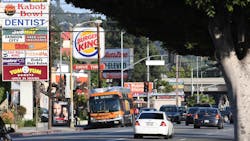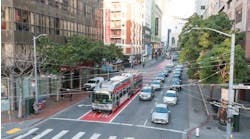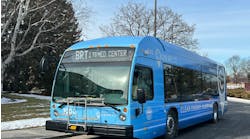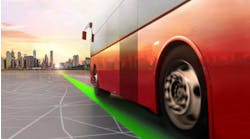Los Angeles County Metropolitan Transportation Authority (L.A. Metro) staff are briefing the board of directors on the Better Bus Program, a $2.1-billion five-year plan that aims to improve the bus system to address racial inequities and to provide quicker trips and a more comfortable experience for riders.
A discussion of Better Bus took place in the board’s Operations, Safety and Customer Experience Committee March 18, which was also livestreamed.
The goals of Better Bus are to speed up the buses on streets, improve the ease and convenience of riding the bus, and improve the safety and comfort while waiting at bus stops as well as on board buses. The elements of the plan seek to address persistent issues that riders have long complained about. Here are a few of the proposed improvements:
- Add more bus lanes and traffic signal priority.
- Improve on-time performance.
- Improve cleanliness.
- Supply more reliable real-time information to riders.
- Increase options for security.
- Modernize bus stops by adding better seating, shelter from the elements and upgraded lighting.
Stakeholders and riders who closely follow L.A. Metro may recognize that elements of Better Bus are also key components of other L.A. Metro plans. The idea here is to create a program that consolidates all of L.A. Metro’s bus upgrades under one roof — something L.A. Metro has not done in the past.
There is no doubt that Better Bus is a timely and critical effort.
Even before the ongoing COVID-19 pandemic began, L.A. Metro ran the third busiest bus system in the United States. The bus system consistently carries about 75 percent of riders in any given year and that number has inched upward during the pandemic.
As was the case prior to COVID-19, bus riders who have continued to ride during the pandemic are mostly Latino or Black and are more likely to work in essential jobs and live in neighborhoods that have taken the brunt of the pandemic in terms of the number of cases, deaths and higher unemployment.
On top of that, most bus riders already live in economically distressed neighborhoods; the annual median household income of bus riders remains at a $18,000.
The bottom line: L.A. Metro's system of 2,200 buses and 123 routes is a mobility lifeline for many riders — with thousands of bus stops close to peoples’ homes, jobs and other critical destinations.
Better Bus began as an internal working group at L.A. Metro to coordinate ongoing bus projects that span a variety of departments. Going forward, the authority says it believes Better Bus is the best way for riders and stakeholders to track the important work its doing.
Better Bus will build on efforts that are underway.
Most prominently, the L.A. Metro Board last fall approved the NextGen Bus Plan, the first overhaul of L.A. Metro’s bus routes in more than 20 years. NextGen took a hard look at routes and ridership and aimed to put bus service where it’s needed the most while increasing frequency on most routes.
The first round of NextGen changes went into effect in December and L.A. Metro will be installing the rest of the NextGen changes in June and September — when the authority restores the full amount of pre-pandemic bus service.
The L.A. Metro Board in late 2020 approved L.A. Metro’s first Customer Experience Plan, which includes 37 bus-specific improvements that are in the planning stages or underway. These upgrades will be part of Better Bus and among them are several that received initial funding as part of L.A. Metro’s current fiscal year budget:
- A pilot program to provide emergency shelter vouchers for unhoused riders.
- A pilot program that quickly identifies riders impacted by a missed run or pass-up in real-time and offers them a free ride code for an on-demand shared ride service to get them where they need to go.
- A Digital Rider Alert system to enable riders to receive customized service and emergency alerts through text messages and other channels.
An annual customer survey of L.A. Metro Riders conducted last year reaffirmed the pain points that bus riders experience — including unreliable and slow buses, long wait times, insufficient delay or service advisory information, uninviting bus stops and, in particular, concerns about safety and homelessness.
Addressing these concerns is the core of Better Bus. Of course, improvements do have costs. Much of L.A. Metro’s available funding is already assigned to operations (including state of good repair) and transit expansion. Better Bus is already partially funded, and staff will return to the board in the spring with a proposed funding strategy, including options for state and federal grants and the use of existing funds, for the rest of the improvements.



